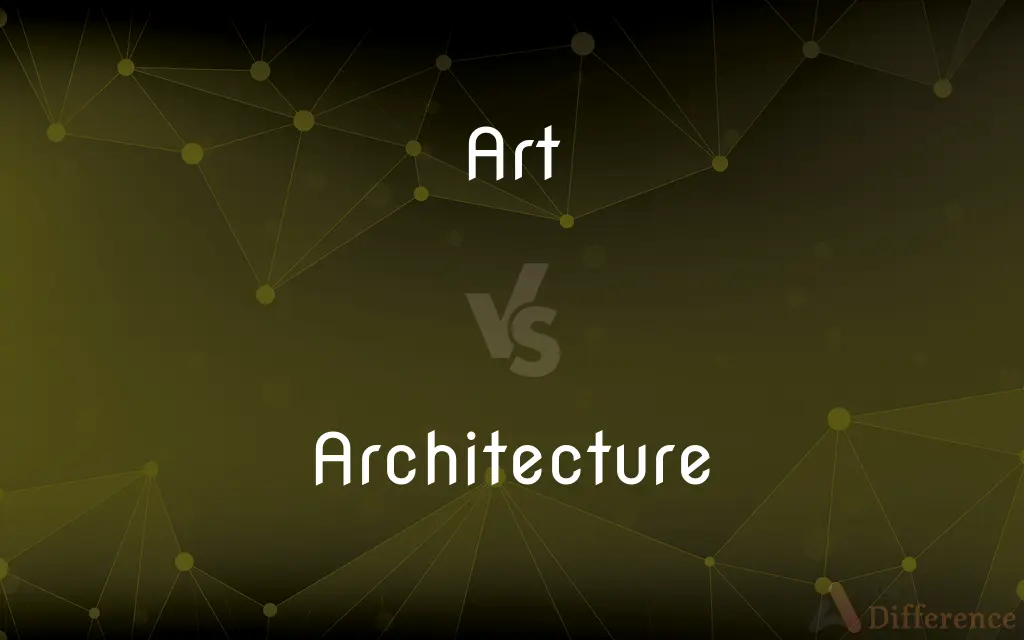Art vs. Architecture — What's the Difference?
By Tayyaba Rehman & Urooj Arif — Updated on March 7, 2024
Art encompasses diverse creative expressions, focusing on emotional and conceptual impact, while architecture combines aesthetics with functionality, shaping our living environments.

Difference Between Art and Architecture
Table of Contents
ADVERTISEMENT
Key Differences
Art is a broad category that includes paintings, sculptures, and other forms designed primarily for aesthetic and emotional engagement. On the other hand, architecture is the art and science of designing and constructing buildings and structures, emphasizing both form and function to create usable spaces.
While art often seeks to evoke an emotional response or express an artist's vision, architecture integrates aesthetic principles with practical considerations like safety, efficiency, and the needs of its users. Whereas art can exist purely for its own sake, architecture inherently serves a functional purpose.
Artists have the liberty to experiment with various mediums and styles, from traditional to contemporary, without the constraints of utility. In contrast, architects must adhere to building codes, environmental considerations, and structural integrity, which significantly influences their creative decisions.
The appreciation of art is subjective, relying on individual interpretation and personal taste. Conversely, architecture, while also subject to aesthetic judgment, requires a broader consensus on its practicality and sustainability, impacting a wider community.
Both art and architecture reflect the cultural, social, and historical context of their time, serving as a record of human expression and societal values. However, architecture's scale and permanence often make it a more visible and influential marker of a specific era or place.
ADVERTISEMENT
Comparison Chart
Primary Focus
Aesthetic and emotional expression
Functional design and aesthetics
Forms
Paintings, sculptures, etc.
Buildings, bridges, etc.
Purpose
Evoke emotions, express ideas
Provide usable spaces
Constraints
Fewer, mainly conceptual
Building codes, functionality, safety
Medium and Style
Diverse, no practical limits
Influenced by practical needs
Appreciation
Highly subjective
Balances aesthetics and usability
Cultural Role
Reflects and questions society
Shapes living environments
Visibility
Personal or gallery spaces
Public and communal spaces
Compare with Definitions
Art
A medium of expression through various forms.
The gallery's new exhibit showcases art from diverse cultures.
Architecture
The design and construction of buildings.
The new library is a marvel of contemporary architecture.
Art
Focuses on emotional and conceptual impact.
Modern art often challenges viewers to find their own interpretations.
Architecture
Subject to codes and practical needs.
The architect incorporated green technologies to meet sustainability standards.
Art
Reflects personal or societal narratives.
The mural downtown captures the city's vibrant history through art.
Architecture
Influences and defines public spaces.
Iconic architecture has transformed our city's skyline and public areas.
Art
Highly subjective in appreciation.
Abstract art divides opinions, highlighting its subjective appeal.
Architecture
Reflects cultural and historical contexts.
Ancient architecture gives us insights into civilizations' technological advances and societal structures.
Art
Unbounded by practical constraints.
The artist used recycled materials to push the boundaries of traditional art.
Architecture
Balances aesthetics with functionality.
Good architecture not only looks appealing but also serves its intended purpose efficiently.
Art
Art is a diverse range of (and products of) human activities involving creative imagination to express technical proficiency, beauty, emotional power, or conceptual ideas.There is no generally agreed definition of what constitutes art, and ideas have changed over time. The three classical branches of visual art are painting, sculpture, and architecture.
Architecture
Architecture (Latin architectura, from the Greek ἀρχιτέκτων arkhitekton "architect", from ἀρχι- "chief" and τέκτων "creator") is both the process and the product of planning, designing, and constructing buildings or other structures. Architectural works, in the material form of buildings, are often perceived as cultural symbols and as works of art.
Art
The conscious use of the imagination in the production of objects intended to be contemplated or appreciated as beautiful, as in the arrangement of forms, sounds, or words.
Architecture
The art and science of designing and erecting buildings.
Art
Such activity in the visual or plastic arts
Takes classes in art at the college.
Architecture
Buildings and other large structures
The low, brick-and-adobe architecture of the Southwest.
Art
Products of this activity; imaginative works considered as a group
Art on display in the lobby.
Architecture
A style and method of design and construction
Byzantine architecture.
Art
A field or category of art, such as music, ballet, or literature.
Architecture
Orderly arrangement of parts; structure
The architecture of the federal bureaucracy.
The architecture of a novel.
Art
A nonscientific branch of learning; one of the liberal arts.
Architecture
(Computers) The overall design or structure of a computer system or microprocessor, including the hardware or software required to run it.
Art
A skill that is attained by study, practice, or observation
The art of negotiation.
Architecture
Any of various disciplines concerned with the design or organization of complex systems
Enterprise architecture.
Art
Arts Artful devices, stratagems, and tricks.
Architecture
The art and science of designing and managing the construction of buildings and other structures, particularly if they are well proportioned and decorated.
The architecture throughout NYC is amazing.
Art
Artful contrivance; cunning.
Architecture
The profession of an architect.
Art
(Printing) Illustrative material, especially in contrast to text.
Architecture
Any particular style of building design.
Art
A second person singular present indicative of be.
Architecture
Construction, in a more general sense; frame or structure; workmanship.
Art
(uncountable) The conscious production or arrangement of sounds, colours, forms, movements, or other elements in a manner that affects the senses and emotions, usually specifically the production of the beautiful in a graphic or plastic medium.
There is a debate as to whether graffiti is art or vandalism.
Architecture
A unifying structure.
Art
(uncountable) The creative and emotional expression of mental imagery, such as visual, auditory, social, etc.
Architecture
(computing) A family of CPUs sharing a common instruction set and having partial or full compatibility with software built on each other.
Art
(countable) Skillful creative activity, usually with an aesthetic focus.
She's mastered the art of programming.
Architecture
(computing) A specific model of a microchip or CPU.
The Intel architectures have more software written for them.
Art
(uncountable) The study and the product of these processes.
He's at university to study art.
Architecture
The structure and design of a system or product.
The architecture of the company's billing system is designed to support its business goals.
Art
(uncountable) Aesthetic value.
Her photographs are nice, but there's no art in them.
Architecture
The art or science of building; especially, the art of building houses, churches, bridges, and other structures, for the purposes of civil life; - often called civil architecture.
Many other architectures besides Gothic.
Art
(uncountable) Artwork.
Sotheby's regularly auctions art for millions.
Art collection
Architecture
Construction, in a more general sense; frame or structure; workmanship.
The architecture of grasses, plants, and trees.
The formation of the first earth being a piece of divine architecture.
Art
(countable) A field or category of art, such as painting, sculpture, music, ballet, or literature.
I'm a great supporter of the arts.
Architecture
An architectural product or work
Art
(countable) A nonscientific branch of learning; one of the liberal arts.
Architecture
The discipline dealing with the principles of design and construction and ornamentation of fine buildings;
Architecture and eloquence are mixed arts whose end is sometimes beauty and sometimes use
Art
(countable) Skill that is attained by study, practice, or observation.
Architecture
The profession of designing buildings and environments with consideration for their esthetic effect
Art
Contrivance, scheming, manipulation.
Architecture
(computer science) the structure and organization of a computer's hardware or system software;
The architecture of a computer's system software
Art
The second person singular, indicative mode, present tense, of the substantive verb Be; but formed after the analogy of the plural are, with the ending -t, as in thou shalt, wilt, orig. an ending of the second person sing. pret. Cf. Be. Now used only in solemn or poetical style.
Art
The employment of means to accomplish some desired end; the adaptation of things in the natural world to the uses of life; the application of knowledge or power to practical purposes.
Blest with each grace of nature and of art.
Art
A system of rules serving to facilitate the performance of certain actions; a system of principles and rules for attaining a desired end; method of doing well some special work; - often contradistinguished from science or speculative principles; as, the art of building or engraving; the art of war; the art of navigation.
Science is systematized knowledge . . . Art is knowledge made efficient by skill.
Art
The systematic application of knowledge or skill in effecting a desired result. Also, an occupation or business requiring such knowledge or skill.
The fishermen can't employ their art with so much success in so troubled a sea.
Art
The application of skill to the production of the beautiful by imitation or design, or an occupation in which skill is so employed, as in painting and sculpture; one of the fine arts; as, he prefers art to literature.
Art
Those branches of learning which are taught in the academical course of colleges; as, master of arts.
In fearless youth we tempt the heights of arts.
Four years spent in the arts (as they are called in colleges) is, perhaps, laying too laborious a foundation.
Art
Learning; study; applied knowledge, science, or letters.
So vast is art, so narrow human wit.
Art
Skill, dexterity, or the power of performing certain actions, acquired by experience, study, or observation; knack; as, a man has the art of managing his business to advantage.
Art
Skillful plan; device.
They employed every art to soothe . . . the discontented warriors.
Art
Cunning; artifice; craft.
Madam, I swear I use no art at all.
Animals practice art when opposed to their superiors in strength.
Art
The black art; magic.
In America, literature and the elegant arts must grow up side by side with the coarser plants of daily necessity.
Art
The products of human creativity; works of art collectively;
An art exhibition
A fine collection of art
Art
The creation of beautiful or significant things;
Art does not need to be innovative to be good
I was never any good at art
He said that architecture is the art of wasting space beautifully
Art
A superior skill that you can learn by study and practice and observation;
The art of conversation
It's quite an art
Art
Photographs or other visual representations in a printed publication;
The publisher was responsible for all the artwork in the book
Common Curiosities
Can architecture be considered a form of art?
Yes, architecture is often considered a form of art that encompasses functional and aesthetic dimensions, but it must also meet practical and safety requirements.
What distinguishes art from architecture?
Art focuses on aesthetic and emotional expression without practical constraints, while architecture combines form and function within design and construction principles.
How do personal tastes affect the appreciation of art and architecture?
Personal tastes highly influence art appreciation due to its subjective nature, while architectural appreciation also considers functionality and community impact.
How do architects balance aesthetics and practical considerations?
Architects use creative solutions to integrate aesthetic values with functional requirements, often incorporating innovative materials and technologies.
What role does culture play in art and architecture?
Both reflect and influence cultural and societal values, but architecture also physically shapes living environments and public spaces.
How do art and architecture serve as records of history?
They capture the cultural, social, and technological advancements of their times, with architecture offering a more permanent and visible record.
What makes a building iconic in the realm of architecture?
Iconic buildings often feature unique design, historical significance, or cultural impact, becoming landmarks within their environments.
Can art influence architectural design?
Yes, artistic principles and aesthetics can significantly influence architectural design, inspiring innovative forms and spaces.
Are there any restrictions on creativity in art compared to architecture?
Art faces fewer restrictions, allowing for greater experimentation. In contrast, architecture must adhere to building codes, environmental considerations, and structural integrity.
What is the importance of functionality in architecture?
Functionality is crucial in architecture as it ensures buildings meet the practical needs of their users, including safety, comfort, and efficiency.
What challenges do architects face today?
Architects face challenges such as adapting to climate change, meeting the needs of growing urban populations, and integrating technology into sustainable designs.
How does the public interact with art and architecture differently?
Art is often experienced in personal or gallery settings, while architecture is encountered in everyday public and private spaces, impacting a broader audience.
Can architectural designs be considered intellectual property?
Yes, architectural designs can be protected as intellectual property, recognizing the creativity and originality of architects.
What impact do building codes have on architecture?
Building codes ensure safety, accessibility, and sustainability, influencing architectural design and construction practices.
How does sustainability play a role in modern architecture?
Sustainability is increasingly central to modern architecture, focusing on energy efficiency, environmental impact, and resource conservation.
Share Your Discovery

Previous Comparison
Periscope vs. Telescope
Next Comparison
Holla vs. HolaAuthor Spotlight
Written by
Tayyaba RehmanTayyaba Rehman is a distinguished writer, currently serving as a primary contributor to askdifference.com. As a researcher in semantics and etymology, Tayyaba's passion for the complexity of languages and their distinctions has found a perfect home on the platform. Tayyaba delves into the intricacies of language, distinguishing between commonly confused words and phrases, thereby providing clarity for readers worldwide.
Co-written by
Urooj ArifUrooj is a skilled content writer at Ask Difference, known for her exceptional ability to simplify complex topics into engaging and informative content. With a passion for research and a flair for clear, concise writing, she consistently delivers articles that resonate with our diverse audience.














































